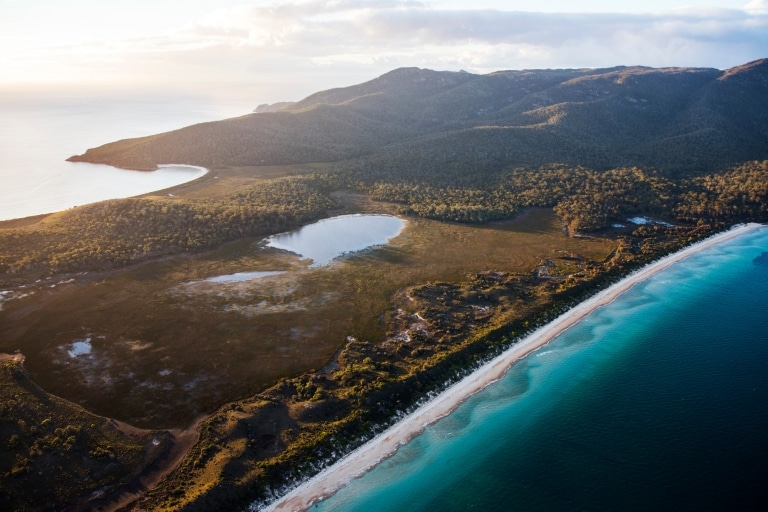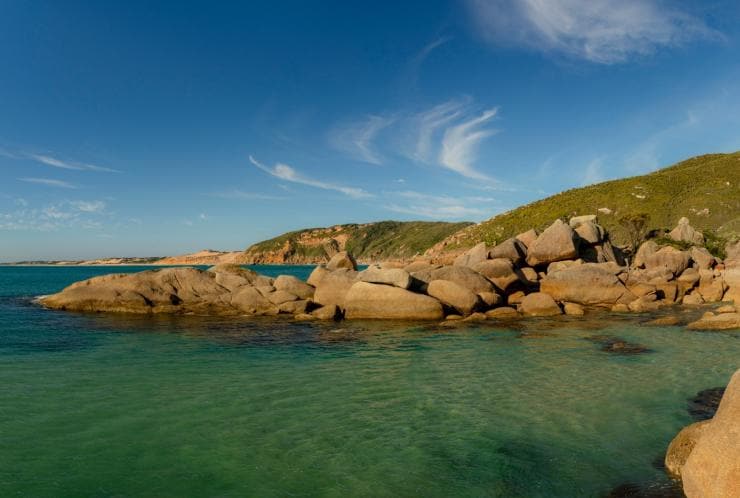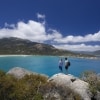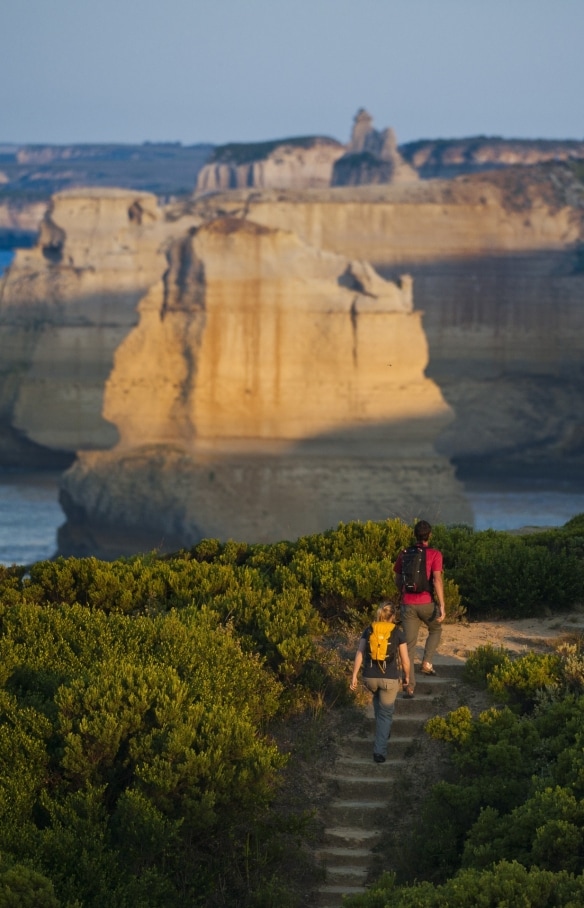
Hazards Beach, Freycinet National Park, Tasmania © Lauren Bath
Australia's best day hikes
From red sand desert to blue lagoons, Australia’s hikes take in the country’s most rugged nature.
Tongue Point, Wilsons Promontory
Tongue Point, Wilsons Promontory
- Duration: 5 hours
- Distance: 10km (6.2mi)
- Grade: Moderate to difficult
Wilsons Promontory is known for its many walking trails and the Tongue Point Walk is one of the most beautiful. Begin at the Darby River car park (about three hours from Melbourne) before venturing along the forested coastline. If you’d like to add a bit of extra beauty to your day, diverge onto the Fairy Cove track to discover a secluded beach dotted with giant boulders and rock pools. Don’t forget your swimmers for a mid-hike dip.
Mt Gower Trek, Lord Howe Island
Mt Gower Trek, Lord Howe Island
- Duration: 8 hours
- Distance: 14km (8.6mi)
- Grade: Difficult
Lord Howe Island, a two-hour flight from Sydney, is known for its spectacular walks, including the multi-day Seven Peaks Walk. If you only have a day, you can still take in some of the island’s most astounding nature on the Mt Gower Trek, known as one of Australia’s best day walks. Along the way, you’ll enjoy a view of Ball’s Pyramid, beautiful lagoons and misty forests. Because of its challenging climbs and dizzying drops, hikers are required to walk with a licensed guide.
Grand Canyon Track, Blue Mountains
Grand Canyon Track, Blue Mountains
- Duration: 3 hours
- Distance: 6.3km (3.9mi)
- Grade: Moderate
The World Heritage-listed Blue Mountains is teeming with nature trails, but arguably the most enchanting is the Grand Canyon in Blackheath. The circuit begins with a showstopper view across the valley from Evans Lookout, before descending into the heart of the luscious rainforest. Wander along fairytale-like stepping stones and past moss-coated trees, trickling waterfalls and striking sandstone walls.
Heysen Trail Loop, Adelaide
Heysen Trail Loop, Adelaide
- Duration: 7 hours
- Distance: 13km (8mi)
- Grade: Moderate
The Adelaide Hills is known for its cool-climate wines, but just steps from the vineyards lie incredible hiking opportunities. At 1,200km (745 mi) long, the Heysen Trail is one of the longest dedicated walking trails in the country. Take on a section of the walk on the one-day Heysen Trail Loop. The loop treks through native forest and along the ridgeline to Little Mount Crawford. Nearby you’ll find campsites perfect for a post-hike night under the South Australian stars.
Box Forest Circuit, Lamington National Park
Box Forest Circuit, Lamington National Park
- Duration: 4 hours
- Distance: 11km (6.8mi)
- Grade: Moderate to difficult
In Lamington National Park – about an hour from the Gold Coast – you’ll find vibrant Gondwana rainforest, home to ancient trees and extensive walking tracks. If you’re eager to seek out tumbling waterfalls, trickling streams and moss-covered rocks, then it’s time to embark on the Box Forest Circuit. After diverging from the Border Track, you’ll be canopied by enormous pink-barked brush box trees, some of the oldest carbon-dated trees on mainland Australia, before reaching a collection of picturesque waterfalls.
Valley of the Winds Walk, Kata Tjuta
Valley of the Winds Walk, Kata Tjuta
- Duration: 3 to 4 hours
- Distance: 7.4km (4.5mi)
- Grade: Moderate to difficult
Of all the day walks in Australia, perhaps the most spectacular are those in the Red Centre, the spiritual epicentre of the country. The Valley of the Winds walk takes hikers among the magnificent red domes of Kata Tjuta. You’ll walk through the towering boulders, stopping at lookouts and descending into a hidden amphitheatre on a deeply immersive journey. Kata Tjuta rests on the land of the Anangu people, who have lived here for tens of thousands of years.
Rim Walk, Kings Canyon
Rim Walk, Kings Canyon
- Duration: 3 to 4 hours
- Distance: 6km (3.7mi)
- Grade: Moderate to difficult
The Kings Canyon Rim Walk in the Northern Territory overflows with awe-inspiring nature. Depart at sunrise, when the sandstone ripples with oranges and reds as shadows pass. The walk begins with a challenging – yet rewarding – ascent of about 500 steep stairs, before reaching the domes of the Lost City, so-called for their ancient, city-in-ruins resemblance. You’ll then descend into the Garden of Eden, a rock hole surrounded by greenery, and back out again to take in unbelievable views of the canyon.
Wineglass Bay and Hazards Beach circuit, Freycinet National Park
Wineglass Bay and Hazards Beach circuit, Freycinet National Park
- Duration: 4 to 5 hours
- Distance: 11km (6.8mi)
- Grade: Moderate to difficult
A two-hour drive from Launceston, Wineglass Bay’s perfectly curved lagoon acts as a border between azure ocean waters and dense green forest. On the Wineglass Bay and Hazards Beach circuit, you can both marvel at the bay from the lookout and get up close on its squeaky white sand. Along the way, you’ll pass scenic lookouts, orange-lichen boulders and native forests, typically rustling with adorable wallabies and pademelons.
The Loop Walk and Nature’s Window, Kalbarri
The Loop Walk and Nature’s Window, Kalbarri
- Duration: 3 hours
- Distance: 9km (5.5mi)
- Grade: Difficult
Kalbarri National Park, six hours from Perth, is known for its unique landscape of inland gorges carved over 400 million years ago. During the cooler months, you can marvel at the deep red and white banded rocks along the Loop Walk, starting at Nature’s Window, a sandstone rock arch that frames the Murchison River. The remaining loop is both challenging and adventurous. Expect to scramble rocks, traverse sandy beaches and feel fully immersed in this unique, ancient gorge system.































































































































































